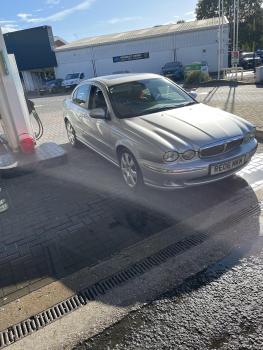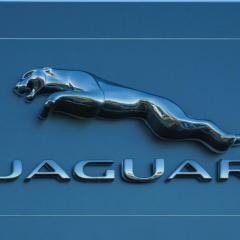Leaderboard
Popular Content
Showing content with the highest reputation since 12/22/2024 in all areas
-
Having switched my allegiance from SAAB to Jaguar in or around 2008, purchased my first XF (Diesel second hand ) in 2010. See below next to my last Saab which I also still have. Owned two further XFs before switching to my current 2017 XF-S supercharged petrol. Love this car and will probably hang on to it forever 😜 . No intention of switching to EV despite test driving a Tesla S in 2019 ( ludicrous mode is exactly what it is) .3 points
-
3 points
-
Hi all, For information, the Climate Control Unit module (passenger footwell) was defective. Impossible to reach screws, so just cable tied replacement unit to defective unit. Mike2 points
-
....also I would check the age of your "new" tyres. Code for date is last 4 digits following DOT on the sidewall, first two are the week number and last two the year. So 0101 would show tyres made in the first week of 2001. If your code is 3 figures they are older than 2000 so are downright dangerous! https://btmauk.com/2021/01/26/dot-code-celebrates-50-year-anniversary/ Regards John2 points
-
Having worked most of my life in electrical/electronic engineering, I can confirm there is nothing more frustrating than having to write on the job sheet "NFFAT" - No Fault Found At Test. Over the decades ive had many "Intermittently Intermittent" faults as i call them. Sometimes it's has been a long and extremely annoying process to find the fault and often when i do, i find it's a "Compound Intermittent Fault" - one where two or more problems contribute to not only the intermittent fault but the overall intermittency of it occurring in the first place. I wish you and your autoelectrician luck with finding it, you may have to lose this battle to win the war and come to an arrangement with him whereby he comes to you when it faults to investigate. This isn't just a "Jag thing", it happens to all makes and some are much worse than others! 'Tis the nature of the beast with electrical/electronic systems sadly.2 points
-
2 points
-
Hi Lez. At that age you are probably going to struggle to get decent cover as most are limited to 10 years or 100k after which cover limit and items covered drops substantially. There are some that will go to 12 years and 120k but personally at 10yrs I would be going with your AA option and laying aside a couple of hundred a month in a savings account to "self insure" Good luck John2 points
-
Hello. I am new to Jaguar and this club, living in North Hampshire. I have a 2017 XF 2.0 D, Recently need timing chain replacement including upgrade to prevent a recurrence. Fortunately covered by dealer warranty. Prior to negotiating the repair I funded a test £200 + vat) on a main dealer rig to know for sure if new chain was needed. Result was clear. Engine now sounds better and seems a bit more responsive. Sorry this may not be of any real help to you, but the failed test result came with dire warnings of possible outcomes if the job was not done. I expect you are aware of these. All the Best and Regards, Brian C2 points
-
Free to a good home 1999 jaguar s type front and rear bumpers shells. In mistral blue. Taken from my 1999 3.0 se. Car long gone but have some spares in the garage. Had no plans to get another but now have a 2007 2.7d. So body panels will fit but bumpers a different style Need the space in my garage and they will Free Collection only Message me here Or email [email protected]2 points
-
Owned my new Jaguar for 3 weeks , wasn't expecting a Jag to be my first car but something just felt right about it! It’s a Jaguar X type 3.0 v6 sovereign edition! If someone could maybe advise how rare these are (if they are in anyway!) and if they are sought after that would be great? As noticed not many for sale and registered , Happy to have joined!2 points
-
2 points
-
Thank you all for your help and advice! I have managed to get into the boot via the ‘secret’ keyhole!2 points
-
2 points
-
Hi, just popped by to introduce myself. I’m Andy, 55 from Market Rasen, Lincolnshire. Purchased my first Jaguar (X351), 2016 with 45,500 on 14th February this year and it’s been an eventful few months. 1 day after the dealer 3 month warranty expired she spun a bearing. Fortunately for me I ‘persuaded’ the dealer that the Consumer Rights act covered the vehicle for 6 months from purchase. So they picked her up and took her on a little jaunt around several specialists until they settled on a suitable place to have the work done. Good old InControl letting me track the movements (as well as the air tag onboard!). After 10 & a half weeks of constantly chasing I was able to collect the car and bring her home. You’d think the story would brighten up from there but….. as soon as I hit the motorway she went in to RP and as I didn’t have my OBD with me I wasn’t able to get a fix on the issue. Limped home as I suspected an air leak which was what the codes showed me. I wasn’t prepared to send her back to the dealer again after the way things had gone and set about resolving it. changed MAF A, MAP and cleaned out throttle body (which was badly choked up). Still getting RP periodically but not with any particular set of conditions. Eventually found the air intake pipe from MAF B to turbo was not connected to the turbo. No wonder I was getting RP and soot deposits on the tailpipes. Spent a considerable amount of time at the weekend figuring out how to get the pipe back on when there is zero room for tools down at the turbo to hold the spring clip open enough. Eventually got it sorted and secured. Cleared the DTC again. Hooked up SDD and ran through install throttle body, turbo etc and finally all codes cleared. Now drives like the car I was expecting and I really look forward to getting in and driving with no faults or RP. Sorry for the long story. Just so chuffed to have my car back.2 points
-
2 points
-
You don’t see many 3.0’s , just make sure the sills are solid behind the skirts (you need to remove them to check properly) mostly I seem to spot diesels.2 points
-
The elimination of Jaguar ICE automobiles can be summed up in one word, tragic.2 points
-
I posted a video on YouTube on an easy way to remove broken wheel nuts. It's really easy. I'll try and find the link https://youtu.be/p3WruqvSLqg?si=rFQ5DfAvIKzjmBsG2 points
-
If you can, find another headlamp and unplug your offside/drivers headlamp and plug the wiring into the "spare" unit. If the fault persists, it's not the headlamp, if the DRL comes up bright on the spare unit then it's the light unit. However, you may find if the spare is bright, the original might "miraculously" become bright - this points to corroded/dirty connections within the plugs.2 points
-
did you scan it for errors? these are not easy to diagnose, might as simple as wiring, but difficult to track where exactly2 points
-
Dim lights usually points to a poor earth connection. Check the earth point for corrosion on the relevant headlight. N6 JMX2 points
-
Thanks mate, I will contact them, as it happens one of my friends just mentioned Swallows to me. He told me they are excellent. I'll give them a call and get it booked in. Many thanks for your help, if there's anything I can do for you just ask. Cheers Dar2 points
-
Had my car in for it's MOT today, apart from advisories on tyres which are getting replaced next week anyway and rear brake pads which are getting replaced during the service, it had a clean bill of health. Very happy with that, I've owned the car for 12 months and only had to put fuel in it. 😁2 points
-
2 points
-
2 points
-
2 points
-
2 points
-
Steve, just as an aside, I know no longer pertinent to your original question, but: a good turn out at an X150 seminar organised by the JEC last weekend. One of the key points related to oil services for the 5L V8. David Marks was the technical/ mechanical guru delivering the presentation His advice was that the single most important maintenance step for the engine was that annual or 6k miles oil replacement/service was not just recommended, but in his experience ,essential for the long and trouble free life of the engine. Further to the regime, critical too that the oil used is CASTROL EDGE PRO, 0-20W, which is specifically recommended for JLRV8 engines. This oil even if your filler cap states 5-20, as Jaguar later a made advisory that 0-20 is the recommended grade.2 points
-
For future info, where the vehicle is fitted with an Auxiliary Battery, this feeds the electronics whilst the vehicle is operating in start / stop mode, maintaining a constant 12V supply to the sensitive electronics. If you find, over time, that the start / stop function fails to operate, it can be due to either battery beginning to fail. The main battery obviously provides the capacity to physically crank start the vehicle, whilst the Auxiliary battery provides the stable voltage. Too many restarts in a short space of time, as in crawling traffic, will drop the main battery to the point where it automatically switches off the stop / start functionality until such time as the main battery has recharged itself with engine running. Typically a main battery in a stop / start vehicle will be of the AGM style, and 5-years should be considered as the typical lifespan of the battery before replacement becomes a need. N6 JMX2 points
-
Good Morning Dr Daryl, Welcome to Jaguar Owners😊 Lots of great advice here if needed from the site and members. Best Regards, Aubrey.2 points
-
https://www.ebay.co.uk/itm/306346687269?_trksid=p4375194.c102726.m162918 https://www.ebay.co.uk/itm/127169141692?_trksid=p2332490.c101875.m1851 Second link looks to be same wheels but payment in Euros which seems cheaper! Even with the cost of refurb these look the way to go if you want to actually use your new toy and not simply look at it on the drive 🙂 Good luck John1 point
-
Locate and check the headlight earth connection is sound. One light failing is more likely to be an earthing issue than a BCM issue. N6 JMX1 point
-
Hi Colin, you indicate your problem is with the X-150 model, but your profile descripting infers you have the X-100 model from 2001, need to clarify which model you have the issue with. Before you changed the battery, did you have any need to jump start the car? If yes, then you may have fried the video screen that is the display in the X-150 model. N6 JMX1 point
-
Finally solved map upgrade issues. Jaguar where excellent 🏆Lloyds jaguar Houghton le spring did themselves proud with a little backwards and forward. Dropped of car 8 courtesy car, washed, hoovered returned by 4 . TCU &IMC update. Now my car is talking and I can update maps and live coverage. Cost was bearable, experience sometimes frustrating but a positive outcome1 point
-
Hi Rebecca, assuming you can get into the car itself, open the bonnet. There you will find a suitable positive and negative post to allow you to fit a 12v power source, such as a battery charger or power pack. This will allow the whole car to power up and you will be able to pop open the boot, using the interior switch or boot lid button, to put the charger leads direct onto the battery. Do not try and start the car from a flat battery situation using the under bonnet posts. I don't believe the secret keyhole will work with a completely flat battery as it still relies on the electrical solenoid to energise the unlock circuit. N6 JMX1 point
-
1 point
-
1 point
-
Look for Swallows Jaguar Specialist right on your doorstep, Bristol Road, Rooksbridge, see link below. Swallows Jaguar Specialist | Servicing, Performance & Motorsport for JLR Fantastic folk who deliver a service that is second to none. Note I have no connection to them. N6 JMX1 point
-
And that is why the insurance company have said it is a total loss. Remember, the selling price includes the sellers profit, your insurance company will not want to pay anything to the sellers profit margin.1 point
-
1 point
-
1 point
-
1 point
-
I'd still buy from Tayna, still the best supplier. Im not surprised though, because you quoted someone called 'Tanya', whoever she is 😉 😂1 point
-
Take them off and spray them with a rattle can. Use a trim removal tool to gently prise the fake vents off. They are held on with about 5 press trim clips1 point
-
Hi all! I've been a long-time Alfa Romeo owner (for close to 20 years...!) and I'm now looking to switch to Jaguars. More specifically, I'd love to find an F-Pace SVR. Can you guys suggest any Jag-specific selling sites other than the usual generic sites such as Autotrader / Gumtree, Facebook, etc.? Once I find the right car, I'm sure I'll be a very active member here! Thanks all.1 point
-
1 point
-
1 point
-
Thanks, everybody, for your input. Battery was checked, tested and replaced a couple of years ago - sounds like it's time to check it again! Goes into garage tomorrow - watch this space.1 point
-
hello everyone, just got my first XKR, 2011 soft top. love the car. I have had 11 previous Jaguars, including 5 f types, 3 f paces, i E pace and a XJS. approaching retirement so bought myself something to keep me occupied.1 point
-
Hi I'm new to the club and the xf is the first jaguar I've owned I'm open to any help and advice thanks1 point

























.thumb.jpg.ded9538683d7bb59a4a0d97bf8ce5631.jpg)
